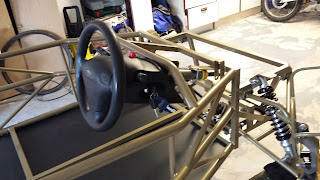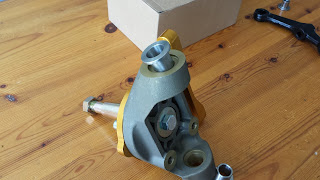Progress has been split between three different stages; stripping the 'busa, engine work and assembling the car.
 |
| One wheel on my wagon |
I'll start with the 'busa strip. It's probably as stripped right now as it's going to get. With the engine out, I salvaged a few other parts that I needed like the dash, rectifier and the brake/clutch pots.
No dramas here really, the excellent Suzuki manual tells you everything you need to know with good diagrams and lots of arrows. I still don't have a manual for the Mevabusa that I'm building, but hopefully it'll be of the same ilk when it shows up.
The rear subframe and wheel are off now and the bike is as light as a feather. I don't have a socket to fit the front axle yet, but it's practically at the stage where I can just throw the remainder into a corner now and dust off my eBay account.
 |
| Not quite a one man job it turns out |
Once it was hoisted up I could winch it into the boot (americans: This means trunk) of my Focus, although in reality I couldn't get the hoist close enough, so I gathered some troops and came home one lunch hour to man handle it in. Paul and Sam were the unlucky helpers but it was fairly easy, the engine isn't that heavy, so even when it came to getting it out the other end it was fairly easy.
 |
| The replacement stud is just under the rightmost port. |
I left it in Steve's capable hands who drilled the bolt out and replaced it with a stud that was glued into place with some atomic glue or something! Sam and Paul once again gave me a hand getting the engine back to base and I gave it a clean once the rain held out. From the engine side, it's now ready to go in I think...
Which brings me onto the car assembly. There's been some discussion and work on the corners getting the bearings and brakes sorted, but I'll put that in a separate post once they're done.
So in preparation for the engine going in, I've put the rear bulkhead in place. Although mostly cut to size by RTR it did need some remaining cuts to get it around the diagonal engine braces on the chassis. They're also sided so I had to be very careful with the measurements. After the cutting I tried it for size and found I'd been too accurate (check me out), where the diagonals meet the main chassis there are blobs of weld so I had to adjust my slots to take those into account.
I wanted to fit the bulkhead with rivnuts now that they're my favourite thing, plus I wanted to get good return on investment on my rivnut gun. It also has the side effect of making it removable which I'm pretty sure I'm going to need for some reason that I don't know about yet.
 |
| Those holes in the floor are meant to be there! |
 |
| The chair in shot isn't part of the final build, I opted for bucket seats instead. |
Not a problem, the nice people where I'd got the vinyl from had given me way more than I'd asked for, so it means that both sides of the bulkhead are carbonified.
I'm quite pleased with the results. It took a lot longer than I imagined, but then everything seems to! I'm also two bolts short of being able to attach it properly, so I'll pick a couple of those up tomorrow to finish it off.










































